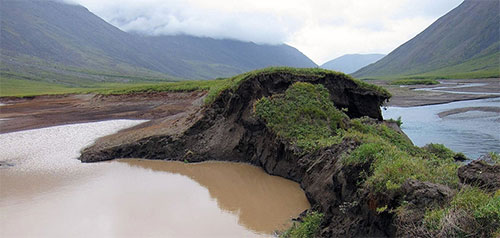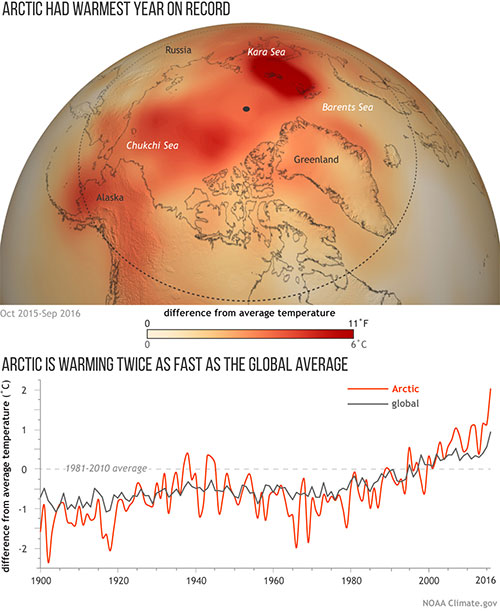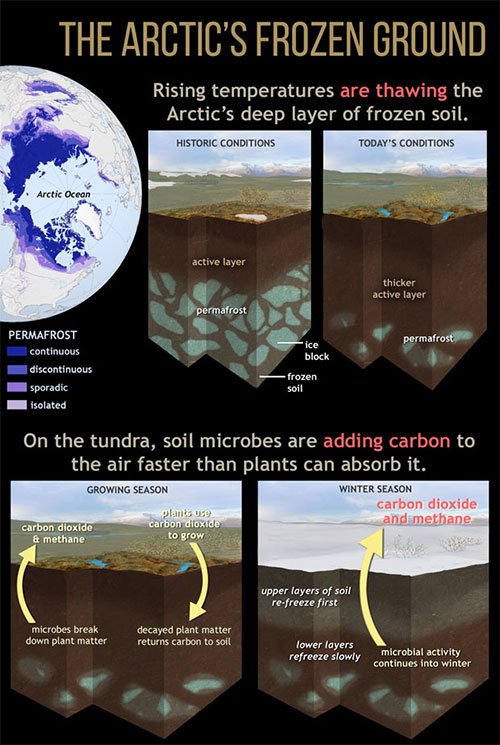
Unprecedented Arctic warmth in 2016 triggers massive decline in sea ice, snow
December 13, 2016
Tuesday PM
(SitNews) - A new NOAA-sponsored report shows that unprecedented warming air temperature in 2016 over the Arctic contributed to a record-breaking delay in the fall sea ice freeze-up, leading to extensive melting of Greenland ice sheet and land-based snow cover.
Now in its 11th year, the Arctic Report Card, released today at the annual American Geophysical Union fall meeting in San Francisco, is a peer-reviewed report that brings together the work of 61 scientists from 11 nations who report on air, ocean, land and ecosystem changes. It is a key tool used around the world to track changes in the Arctic and how those changes may affect communities, businesses and people.

Permafrost is thawing across the Arctic, causing northern lands to sink or change shape, according to the new Arctic Report Card. In Gates of the Arctic National Park, a bank of this lake thawed, allowing the Okokmilaga River to cut through and drain it to the sea.
Photo courtesy National Park Service
“Rarely have we seen the Arctic show a clearer, stronger or more pronounced signal of persistent warming and its cascading effects on the environment than this year,” said Jeremy Mathis, director of NOAA’s Arctic Research Program. “While the science is becoming clearer, we need to improve and extend sustained observations of the Arctic that can inform sound decisions on environmental health and food security as well as emerging opportunities for commerce.”
Five University of Alaska Fairbanks researchers are among the 61 contributors to the report. They include Atmospheric Sciences Professor Uma Bhatt, Vice Chancellor for Research Larry Hinzman, Institute of Arctic Biology Researcher Martha Raynolds, IAB Professor Donald “Skip” Walker and International Arctic Research Center Chief Scientist John Walsh.
Hinzman co-authored a chapter in the report about the importance of viewing the warming Arctic as an interconnected system, rather than a series of individual changes. That integrated environment is one of the themes of the report.
Hinzman said the contents of the report aren’t surprising. Each subsequent NOAA report has showed an advancing trend toward a warmer Arctic, he said.
“We’ve been on a single trajectory — the temperatures are warming, sea ice is declining, permafrost is thawing,” Hinzman said. “That’s been the theme, year after year after year.”
 Arctic had warmest year on record Arctic had warmest year on record
Graphic courtesy NOAA
Major findings in this year’s report include:
- Warmer air temperature: Average annual air temperature over land areas was the highest in the observational record, representing a 6.3 degree Fahrenheit (3.5 degree Celsius) increase since 1900. Arctic temperatures continue to increase at double the rate of the global temperature increase.
- Record low snow cover: Spring snow cover set a record low in the North American Arctic, where the May snow cover extent fell below 1.5 million square miles (4 million square kilometers) for the first time since satellite observations began in 1967.
- Smaller Greenland ice sheet: The Greenland ice sheet continued to lose mass in 2016, as it has since 2002 when satellite-based measurement began. The start of melting on the Greenland ice sheet was the second earliest in the 37-year record of observations, close to the record set in 2012.
- Record low sea ice: The Arctic sea ice minimum extent from mid-October 2016 to late November 2016 was the lowest since the satellite record began in 1979 and 28 percent less than the average for 1981-2010 in October. Arctic ice is thinning, with multi-year ice now comprising 22 percent of the ice cover as compared to 78 percent for the more fragile first-year ice. By comparison, multi-year ice made up 45 percent of ice cover in 1985.
- Above-average Arctic Ocean temperature: Sea surface temperature in August 2016 was 9 degrees Fahrenheit (5 degrees Celsius) above the average for 1982-2010 in the Barents and Chukchi seas and off the east and west coasts of Greenland.
- Arctic Ocean productivity: Springtime melting and retreating sea ice allowed for more sunlight to reach the upper layers of the ocean, stimulating widespread blooms of algae and other tiny marine plants which form the base of the marine food chain, another sign of the rapid changes occurring in a warming Arctic.

Rising temperatures are thawing the Arctic's deep layer of frozen soil.
Graphic courtesy NOAA
This year’s report also includes scientific essays on carbon dioxide in the Arctic Ocean, on land and in the atmosphere, and changes among small mammals.
- Ocean acidification: More than other oceanic areas, the Arctic Ocean is more vulnerable to ocean acidification, a process driven by the ocean’s uptake of increased human-caused carbon dioxide emissions. Ocean acidification is expected to intensify in the Arctic, adding new stress to marine fisheries, particularly those that need calcium carbonate to build shells. This change affects Arctic communities that depend on fish for food security, livelihoods and culture.
- Carbon cycle changing: Overall, the warming tundra is now releasing more carbon into the atmosphere than it is taking up. Twice as much organic carbon is locked in the northern permafrost as is currently in the Earth’s atmosphere. If the permafrost melts and releases that carbon, it could have profound effects on weather and climate in the Arctic and the rest of the Earth.
- Small mammals: Recent shifts in the population of small mammals, such as shrews, may be the signs of broader consequences of environmental change.
The American Geophysical Union’s fall meeting held this week in San Francisco is the world’s largest Earth and space science meeting.
On the Web:
2016 Arctic Report Cards
http://www.arctic.noaa.gov/Report-Card
Short video of Arctic Report Card 2016.
https://www.youtube.com/watch?v=G0rp6-BEur8&feature=youtu.be
Reporting & Editing by Mary Kauffman, SitNews
Source of News:
Arctic NOAA
www.arctic.noaa.gov
University of Alaska Fairbanks
www.uaf.edu
Representations of fact and opinions in comments posted are solely those of the individual posters and do not represent the opinions of Sitnews.
Submit A Letter to SitNews
Contact the Editor
SitNews ©2016
Stories In The News
Ketchikan, Alaska
|
Articles &
photographs that appear in SitNews may be protected by copyright
and may not be reprinted without written permission from and
payment of any required fees to the proper sources.
E-mail your news &
photos to editor@sitnews.us
Photographers choosing to submit photographs for publication to SitNews are in doing so granting their permission for publication and for archiving. SitNews does not sell photographs. All requests for purchasing a photograph will be emailed to the photographer.
|
|


 Arctic had warmest year on record
Arctic had warmest year on record 